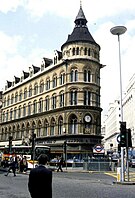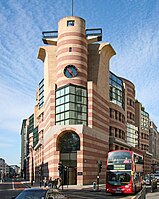Listed building
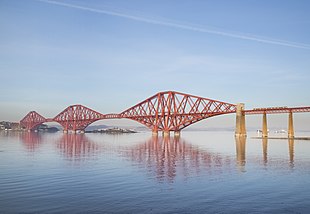
In theUnited Kingdom,alisted building[a]is a structure of particular architectural and/or historic interest deserving of special protection.[1]Such buildings are placed on one of the four statutory lists maintained byHistoric EnglandinEngland,Historic Environment ScotlandinScotland,CadwinWales,and theNorthern Ireland Environment AgencyinNorthern Ireland.The classification schemes differ between England and Wales, Scotland, and Northern Ireland (see sections below). The term has also been used in theRepublic of Ireland,where buildings are protected under the Planning and Development Act 2000, although the statutory term in Ireland is "protected structure."[2]
A listed building may not be demolished, extended, or altered without special permission from the local planning authority, which typically consults the relevant central government agency. InEngland and Wales,a nationalamenity societymust be notified of any work to be done on a listed building which involves any element of demolition.[3]
Exemption from secular listed building control is provided for some buildings in current use for worship, but only in cases where the relevant religious organisation operates its own equivalent permissions procedure. Owners of listed buildings are, in some circumstances, compelled to repair and maintain them and can face criminal prosecution if they fail to do so or if they perform unauthorised alterations. When alterations are permitted, or when listed buildings are repaired or maintained, the owners are often required to use specific materials or techniques.[4]
Although most sites appearing on the lists are buildings, other structures such as bridges, monuments, sculptures, war memorials,milestones and mileposts,and theAbbey Road zebra crossingmade famous bythe Beatles,[5]are also listed. Ancient, military, and uninhabited structures, such asStonehenge,are sometimes instead classified asscheduled monumentsand are protected by separate legislation.[b]Cultural landscapes such as parks and gardens are currently "listed" on a non-statutory basis.
Background[edit]

Although a limited number of 'ancient monuments' were given protection under theAncient Monuments Protection Act 1882,[11]there was reluctance to restrict the owners of occupied buildings in their actions related to their property. The extensive damage to buildings caused byGerman bombingduringWorld War IIprompted efforts to list and protect buildings that were deemed to be of particular architectural merit.[12]Three hundred members of theRoyal Institute of British Architectsand theSociety for the Protection of Ancient Buildingswere dispatched to prepare the list under the supervision of the Inspectorate of Ancient Monuments, with funding from the Treasury.[13]The listings were used as a means to determine whether a particular building should be rebuilt if it was damaged by bombing,[12]with varying degrees of success.[13]In Scotland, the process slightly predated the war withthe Marquess of Bute(in his connections to theNational Trust for Scotland) commissioningthe architect Ian Lindsayin September 1936 to survey 103 towns and villages based on an Amsterdam model using three categories (A, B and C).[14]
The basis of the current more comprehensive listing process was developed from the wartime system. It was enacted by a provision in theTown and Country Planning Act 1947covering England and Wales, and the Town and Country Planning (Scotland) Act 1947 covering Scotland. Listing was first introduced into Northern Ireland under the Planning (Northern Ireland) Order 1972. The listing process has since developed slightly differently in each part of the UK.
Heritage protection[edit]
The process of protecting the built historic environment (i.e. getting aheritage assetlegally protected) is called 'designation'. Several different terms are used because the processes use separate legislation: buildings are 'listed'; ancient monuments are 'scheduled', wrecks are 'protected', and battlefields, gardens and parks are 'registered'. A heritage asset is a part of the historic environment that is valued because of its historic, archaeological, architectural or artistic interest.[15]
Only some of these are judged to be important enough to have extra legal protection through designation. Buildings that are not formally listed but still judged as being of heritage interest can still be regarded as amaterial considerationin the planning process.[16]
As a very rough guide, listed buildings are structures considered of special architectural and historical importance.Ancient monumentsare of 'national importance' containing evidential values, and can on many occasions also relate to below ground or unoccupied sites and buildings.[17]
Eligibility[edit]
Almost anything can be listed. Buildings and structures of special historic interest come in a wide variety of forms and types, ranging from telephone boxes and road signs, to castles. Historic England has created twenty broad categories of structures, and published selection guides for each one to aid with assessing buildings and structures. These include historical overviews and describe the special considerations for listing each category.[18][19]However, in 2020, theSupreme Courtruled inDill v Secretary of State for Housing, Communities and Local Government and anotherthat buildings in the scheme must meet certain criteria – "a three-fold test which involved considering size, permanence and degree of physical attachment" – referred to as theSkerrittstest in reference to a previous legal case in England.[20]Both Historic Environment Scotland andCadwproduce guidance for owners.[21][22]
Listing and delisting procedure[edit]
In England, to have a building considered for listing or delisting, the process is to apply to the secretary of state; this can be done by submitting an application form online toHistoric England.The applicant does not need to be the owner of the building to apply for it to be listed.[19]Full information including application form guidance notes are on the Historic England website. Historic England assesses buildings put forward for listing or delisting and provides advice to the Secretary of State on the architectural and historic interest. The Secretary of State, who may seek additional advice from others, then decides whether to list or delist the building.
England and Wales[edit]
Legislation[edit]
In England and Wales, the authority for listing is granted to the Secretary of State by thePlanning (Listed Buildings and Conservation Areas) Act 1990.Listed buildings in danger of decay are listed on the Historic England'Heritage at Risk' Register.
In 1980 there was public outcry at the sudden destruction of theart decoFirestone Tyre Factory(Wallis, Gilbert and Partners,1928–29). It was demolished over the August bank holiday weekend by its ownersTrafalgar House,who had been told that it was likely to be 'spot-listed' a few days later.[23]In response, the government undertook to review arrangements for listing buildings in order to protect worthy ones from such demolition.[24]After the Firestone demolition, theSecretary of State for the Environment,Michael Heseltine,also initiated a complete re-survey of buildings to ensure that everything that merited preservation was on the lists.[25]
In England, theDepartment for Culture, Media and Sport(DCMS) works withHistoric England(an agency of the DCMS), and other government departments, e.g.Department for Levelling Up, Housing and Communities(DLUHC) and theDepartment for Environment, Food and Rural Affairs(DEFRA) to deliver the government policy on the protection to historic buildings and other heritage assets. The decision about whether or not to list a building is made by the Secretary of State, although the process is administered in England byHistoric England.[26]In Wales (where it is a devolved issue), it is administered byCadwon behalf of theWelsh Parliament.[27]In Scotland it is administered byHistoric Environment Scotlandon behalf of the Scottish Ministers.[21]
English heritage protection reform[edit]
There have been several attempts to simplify the heritage planning process for listed buildings in England.[28]As of 2021, few changes had been implemented.

The review process was started in 2000 byAlan Howarth,then minister at theDepartment for Culture, Media and Sport(DCMS). The outcome was the paper "The Power of Place" in 2000,[29]followed by the subsequent policy document "The Historic Environment: A Force for Our Future", published by the DCMS and theDepartment of the Environment, Transport and the Regions(DTLR) in December 2001.[30]The launch of the Government's Heritage Protection Reform (HPR) report in July 2003 by the DCMS, entitled "Protecting our historic environment: Making the system work better",[31]asked questions about how the current designation systems could be improved. The HPR decision report "Review of Heritage Protection: The Way Forward", a green paper published in June 2004 by the DCMS, committed the UK government andEnglish Heritageto a process of reform, including a review of the criteria used for listing buildings.
A Review of Heritage Policy in 2006 was criticised,[28]and the Government began a process of consultation on changes toPlanning Policy Guidance 15,relating to the principles of selection for listing buildings in England.
The government's White Paper "Heritage Protection for the 21st Century", published on 8 March 2007, offered a commitment to sharing the understanding of the historic environment and more openness in the process of designation.[18]
In 2008, a draft Heritage Protection Bill[32]was subject to pre-legislative scrutiny before its passage through UK Parliament. The legislation was abandoned despite strong cross-party support, to make room in the parliamentary legislative programme for measures to deal with the credit crunch,[33]though it may be revived in future. The proposal was that the existing registers of buildings, parks and gardens, archaeology and battlefields, maritime wrecks, andWorld Heritage Sitesbe merged into a single online register that will "explain what is special and why". English Heritage would become directly responsible for identifying historic assets in England and there would be wider consultation with the public and asset owners, and new rights of appeal. There would have been streamlined systems for granting consent for work on historic assets.[34]
After several years of consultation with heritage groups, charities, local planning authorities, and English Heritage, in March 2010 the DCLG publishedPlanning Policy Statement 5,"Planning for the Historic Environment". This replaced PPG15 and set out the government's national policies on the conservation of the historic environment in England.[16]PPS5 was supported by a Practice Guide, endorsed by the DCLG, the DCMS, and English Heritage,[16]which explained how to apply the policies stated in PPS5.
In December 2010, theDepartment for Communities and Local Governmentannounced that in England all PPSs andPlanning Policy Guidance Noteswould be replaced by a single document, theNational Planning Policy Framework.A consultation draft of this was published on 25 July 2011 and the final version on 27 March 2012. This became a material consideration in planning matters on publication. It has since been revised in 2018, 2019 and 2021.
Categories of listed buildings[edit]

The Historic Buildings and Monuments Commission lists buildings in England and Wales under three grades, with Grade I being the highest grade, as follows:[1]
- Grade I:buildings that are of exceptional interest
- Grade II*:particularly important buildings of more than special interest
- Grade II:buildings that are of special interest[35]
There was formerly a non-statutoryGrade III,which was abolished in 1970.[36][c]Additionally, Grades A, B and C were used mainly forAnglicanchurches in active use, loosely corresponding to Grades I, II* and II. These grades were used mainly before 1977, although a few buildings are still listed using these grades.
In 2010, listed buildings accounted for about 2% of English building stock.[38]In March 2010, there were about 374,000 list entries,[26]of which 92% were Grade II, 5.5% were Grade II* and 2.5% were Grade I.[39]Places of worship are an important part of the UK's architectural heritage; England alone has 14,500 listed places of worship (4,000 Grade I, 4,500 Grade II* and 6,000 Grade II) and 45% of all Grade I listed buildings are places of worship.[40]Some of the listed churches are no longer in use; between 1969 and 2010, some 1,795 churches wereclosed by the Church of England,equalling roughly 11% of the stock, with about a third listed as Grade I or Grade II.[41]
Statutory criteria[edit]

The criteria for listing include architectural interest, historic interest and close historical associations with significant people or events. Buildings not individually noteworthy may still be listed if they form part of a group that is—for example, all the buildings in a square. This is called 'group value'. Sometimes large areas comprising many buildings may not justify listing but receive the looser protection of designation as aconservation area.[1]
The specific criteria include:
- Age and rarity:The older a building is, the more likely it is to be listed. All buildings erected before 1700 that "contain a significant proportion of their original fabric" will be listed. Most buildings built between 1700 and 1840 are listed. After 1840 more selection is exercised and "particularly careful selection" is applied after 1945. Buildings less than 30 years old are rarely listed unless they are of outstanding quality and under threat.
- Aesthetic merits:i.e. the appearance of a building. However, buildings that have little visual appeal may be listed on grounds of representing particular aspects of social or economic history.
- Selectivity:where a large number of buildings of a similar type survive, the policy is only to list the most representative or significant examples.
- National interest:significant or distinctive regional buildings; e.g. those that represent a nationally important but localised industry.
The state of repair of a building isnotgenerally deemed to be a relevant consideration for listing.[1]
Additionally:
- Any buildings or structures constructed before 1 July 1948 that fall within thecurtilageof a listed building are treated as part of the listed building.[42]
- The effect of a proposed development on the setting of a listed building is a material consideration in determining a planning application. Setting is defined as "the surroundings in which a heritage is experienced".[16]
Although the decision to list a building may be made on the basis of the architectural or historic interest of one small part of the building, the listing protection nevertheless applies to the whole building. Listing applies not just to the exterior fabric of the building itself, but also to the interior, fixtures, fittings, and objects within the curtilage of the building even if they are not fixed.[43]De-listing is possible but is rare. One example isAnmer Hallin Norfolk, which was listed in 1984 and de-listed in 1988.
Emergency measure[edit]
In an emergency, the local planning authority can serve a temporary "Building Preservation Notice"(BPN), if a building is in danger of demolition or alteration in such a way that might affect its historic character.[43]This remains in force for six months until the Secretary of State decides whether or not to formally list the building.[44]
Certificates of immunity[edit]
Until the passing of theEnterprise and Regulatory Reform Act 2013an application for aCertificate of Immunity from Listing(CoI) could only be made if planning permission was being sought or had been obtained in England. However, the changes brought about by the Act means that now anyone can ask the Secretary of State to issue a Certificate of Immunity in respect of a particular building at any time.
Alteration[edit]
In England and Wales, the management of listed buildings is the responsibility of local planning authorities and the Department for Communities and Local Government (i.e., not DCMS, which originally listed the building). There is a general principle that listed buildings are put to 'appropriate and viable use' and recognition that this may involve the re-use and modification of the building.[16]However, listed buildings cannot be modified without first obtaining Listed Building Consent through the relevant local planning authority.[45]
In Wales, applications are made using a form obtained from the relevant local authority.[46]There is no provision for consent to be granted in outline. When a local authority is disposed to grant listed building consent, it must first notify the Welsh Parliament (i.e.Cadw) of the application. If the planning authority decides to refuse consent, it may do so without any reference to Cadw.
In Scotland, applications are made on a form obtained from Historic Environment Scotland. After consulting the local planning authority, the owner, where possible, and an independent third party,Historic Environment Scotlandmakes a recommendation on behalf of the Scottish Ministers.[47]
Carrying out unauthorised works to a listed building is a criminal offence and owners can be prosecuted. A planning authority can also insist that all work undertaken without consent be reversed at the owner's expense.
Examples of Grade I listed buildings[edit]

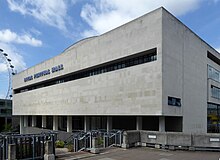
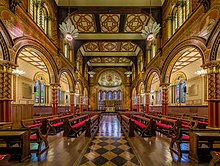
- See alsoCategory:Grade I listed buildingsfor more examples of such buildings across England and Wales.
- Royal Albert Dock,Liverpool
- Birmingham Town Hall,Birmingham
- Blackpool Tower,Blackpool
- Cenotaph,London
- Chequers,Buckinghamshire
- Clifton Suspension Bridge,Bristol
- Hampton Court Palace,London
- Humber Bridge,East Riding of Yorkshire / North Lincolnshire
- Isokon Flats,Hampstead, London
- King's College London Chapel,London
- Liverpool Cathedral,Liverpool
- Lloyd's building,London
- Manchester Liverpool Road railway station,Manchester
- Montacute House,Somerset
- Norwich Castle,Norwich
- Palace of Westminster,London
- Pontcysyllte Aqueduct,North Wales
- Portchester Castle,Hampshire
- Quarr Abbey,Isle of Wight
- Tower Bridge,London
- Tower of London,London
- Warwick Castle,Warwick
- Windsor Castle,Windsor
- York Minster,York
Examples of Grade II* listed buildings[edit]
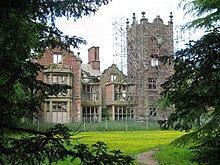

See alsoCategory:Grade II* listed buildingsfor examples of such buildings across England and Wales.
- Battersea Power Station,London
- Capel Manor House,Horsmonden
- Cleveland Bridge,Bath
- Coliseum Theatre,London
- Downe House, Richmond Hill,London
- Liverpool Metropolitan Cathedral,Liverpool
- Manchester Town Hall Extension,Manchester
- Middlesbrough Transporter Bridge,Middlesbrough
- Middlesex Guildhall,London
- Rise Hall,Rise
- Shibden Hall,Calderdale
- St John's Jerusalem,Sutton-at-Hone, Kent
- Trellick Tower,London
Examples of Grade II listed buildings[edit]
See alsoCategory:Grade II listed buildingsfor examples of such buildings across England and Wales.
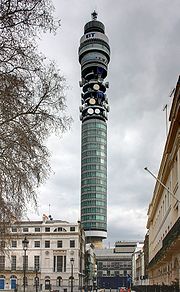
- Abbey Road Studios,London
- Adelphi Hotel,Liverpool
- Broomhill Pool,Ipswich
- BT Tower,London
- Birmingham Back to Backs,Birmingham
- India House,London
- Kursaal,Southend-on-Sea[48]
- Crucible Theatre,Sheffield
- Surbiton railway station,London
- Whitechapel Bell Foundry,London
- Footbridge just south of Wokingham railway station,Wokingham, Berkshire[49][50]
Mixed designations[edit]
It is not unusual for historic sites, particularly large sites, to contain buildings with multiple, sometimes varying, designations. For example,Derwent Valley Mills,aWorld Heritage Sitecontains 838 listed buildings, made up of 16 listed at Grade I, 42 at Grade II* and 780 at Grade II. A further nine structures areScheduled monuments.
Locally listed buildings[edit]
Many councils, for example,Birmingham City CouncilandCrawley Borough Council,[51]maintain a list oflocally listed buildingsas separate to the statutory list (and in addition to it). There is no statutory protection of a building or object on the local list but many receive a degree of protection from loss through being in a Conservation Area or through planning policy. Councils hope that owners will recognise the merits of their properties and keep them unaltered if at all possible.
Northern Ireland[edit]

Listing began later in Northern Ireland than in the rest of the UK: the first provision for listing was contained in the Planning (Northern Ireland) Order 1972; and the current legislative basis for listing is the Planning (Northern Ireland) Order 1991.[53]Under Article 42 of the Order, the relevant Department of theNorthern Ireland Executiveis required to compile lists of buildings of "special architectural or historic interest". Since 2016, the responsibility for the listing process rests with the Historic Environment Division of theDepartment for Communities,[54]which took over the built heritage functions of theNorthern Ireland Environment Agency(formerly the Environment and Heritage Service) following the break up of the Department of the Environment.[55]
Following the introduction of listing, an initial survey of Northern Ireland's building stock was begun in 1974.[56]By the time of the completion of this First Survey in 1994, the listing process had developed considerably, and it was therefore decided to embark upon a Second Survey, which is still ongoing, to update and cross-check the original information. Information gathered during this survey, relating to both listed and unlisted buildings, is entered into the publicly accessible Northern Ireland Buildings Database.[56]
A range of listing criteria, which aim to define architectural and historic interest, are used to determine whether or not to list a building.[53]Listed building consent must be obtained from local authorities before any alteration to a listed structure.[57]There are about 8,500 listed buildings in Northern Ireland,[58]divided into four grades, defined as follows:
- Grade A:"buildings of greatest importance to Northern Ireland including both outstanding architectural set-pieces and the least altered examples of each representative style, period and type."[53]
- Grade B+:"high quality buildings that because of exceptional features, interiors or environmental qualities are clearly above the general standard set by grade B1 buildings. Also buildings which might have merited Grade A status but for detracting features such as an incomplete design, lower quality additions or alterations."[53]
- Grade B1:"good examples of a particular period or style. A degree of alteration or imperfection of design may be acceptable. Generally B1 is chosen for buildings that qualify for listing by virtue of a relatively wide selection of attributes. Usually these will include interior features or where one or more features are of exceptional quality and/or interest."[53]
- Grade B2:"special buildings which meet the test of the legislation. A degree of alteration or imperfection of design may be acceptable. B2 is chosen for buildings that qualify for listing by virtue of only a few attributes. An example would be a building sited within a conservation area where the quality of its architectural appearance or interior raises it appreciably above the general standard of buildings within the conservation area."[53]
Examples of Grade A listed buildings[edit]
- Gosford Castle,County Armagh[59]
- Grand Opera House,Belfast[60]
- Belfast Castle[61]
Examples of Grade B+ listed buildings[edit]
- Necarne,County Fermanagh[62]
- Scrabo Tower,Belfast[63]
Examples of Grade B1 listed buildings[edit]
- Campbell College,Belfast[64]
- Old Bushmills Distillery,County Antrim[65]
- Bank Buildings, Belfast[66]
Scotland[edit]

In Scotland, listing was begun by a provision in the Town and Country Planning (Scotland) Act 1947, and the current legislative basis for listing is theTown and Country Planning (Scotland) Act 1997.[68]As with other matters regarding planning, conservation is a power devolved to theScottish Parliamentand theScottish Government.The authority for listing rests withHistoric Environment Scotland(formerlyHistoric Scotland), anexecutive agencyof the Scottish Government, which inherited this role from the Scottish Development Department in 1991. Listed building consent must be obtained from local authorities before any alteration to a listed structure.[68]
The scheme for classifying buildings is:
- Category A:"Buildings of special architectural or historic interest which are outstanding examples of a particular period, style or building type."[69]
- Category B:"Buildings of special architectural or historic interest which are major examples of a particular period, style or building type."[69]
- Category C:"Buildings of special architectural or historic interest which are representative examples of a period, style or building type."[69]
There are about 47,400 listed buildings in Scotland. Of these, around 8 percent (some 3,800) are Category A, 50 percent are Category B, and 42 percent are listed at Category C.[70]
Examples of Category A listed buildings[edit]

- St Peter's Seminary, Cardross[71]
- Palace of Holyroodhouse,Edinburgh[72]
- Ravelston Garden,Edinburgh[73]
- 1 Prince's Terrace,Glasgow[74]
- Glasgow Cathedral,Glasgow[75]
- Glasgow City Chambers,Glasgow[76]
- Craigellachie Bridge,Moray[77]
- The Kirna,Walkerburn[78]
Examples of Category B listed buildings[edit]
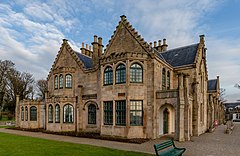
- Balmoral Hotel,Edinburgh[79]
- Harbourmaster's House, Dysart,Fife[80]
- Perth Theatre,Perth[81]
- Sabhal Mòr Ostaig,Isle of Skye[82]
- Torloisk House,Isle of Mull[83]
Examples of Category C listed buildings[edit]
- The Belmont Picturehouse, Aberdeen[84]
- St John's Cathedral, Oban,Argyll[85]
- Craigend Castle,EastDunbartonshire[86]
- TheGeorge Cinema, Portobello,Edinburgh[87]
Records[edit]
England[edit]
Although the 2008 draft legislation was abandoned, Historic England (then part of English Heritage) published a single list of all designatedheritage assetswithin England in 2011.[88]TheNational Heritage List for Englandis an online searchable database which includes 400,000 English Listings, this includes individual listed buildings, groups of multiple listed buildings which share the same listing, scheduled monuments, registered parks and gardens, protected historic wrecks and registered battlefields and World Heritage Sites in one place. The 400,000 in the listing should not be confused with the actual number of listed buildings, which will be much larger than the listing, because a listing can include more than one building that share the same listing number. The legislative frameworks for each type of historic asset remains unchanged.[89]A photographic library of English listed buildings was started in 1999 as a snapshot of buildings listed at the turn of the millennium. This is not an up-to-date record of all listed buildings in England – the listing status and descriptions are only correct as at February 2001.[90]The photographs were taken between 1999 and 2008. It is maintained by the Historic England archive at theImages of Englandproject website. The National Heritage List for England contains the up-to-date list of listed buildings.[91]
Listed buildings in danger of being lost through damage or decay in England started to be recorded by survey in 1991.[92]This was extended in 1998 with the publication of Historic England's Buildings at Risk Register which surveyed Grade I and Grade II* buildings. In 2008 this survey was renamedHeritage at Riskand extended to include all listed buildings, scheduled monuments, registered parks and gardens, registered battlefields, protected wreck sites and conservation areas.[93]The register is compiled by survey using information from local authorities, official and voluntary heritage groups and the general public. It is possible to search this list online.[94]
Scotland[edit]
In Scotland, the national dataset of listed buildings and other heritage assets can be searched online via Historic Environment Scotland,[95]or through the map database Pastmap.[96]ABuildings at Risk Register for Scotlandwas started in 1990 byHistoric Scotlandin response to similar concerns at the number of listed buildings that were vacant and in disrepair.RCAHMSmaintained the register on behalf of Historic Scotland,[97]and provided information on properties of architectural or historic merit throughout the country that are considered to be at risk. Since the merger of these two bodies into one, that work is now carried out by Historic Environment Scotland.
Wales[edit]
Cadwpublishes and maintains a searchable map database for listed buildings in Wales.[98]In Wales, at risk registers of listed buildings are compiled by local planning authorities, and Cadw produced a report in 2009.[99]TheRoyal Commission on the Ancient and Historical Monuments of Wales' (RCAHMW) Emergency Buildings Recording team is responsible for surveying historic buildings threatened with destruction, substantial alteration, or serious decay.
Northern Ireland[edit]
The Northern Ireland Buildings Database contains details of all listed buildings in Northern Ireland.[100]
Other[edit]
British Listed Buildings Online (website)[101]has sections on England, Wales and Scotland. It can be searched either by browsing for listed buildings by country, county and parish/locality, or by keyword search or via the online map. Not all buildings have photographs, as it is run on a volunteer basis.
Equivalent statuses outside the United Kingdom[edit]
For other countries' equivalents seeList of heritage registers.
See also[edit]
- Conservation area (United Kingdom)
- Grade I listed buildings in England by county
- Grade II* listed buildings in England by county
- Grade II listed buildings in England by county
- Historic England Archive
- Images of England
- Register of Historic Parks and Gardens of special historic interest in England
- Scheduled monument
- Site of Special Scientific Interest
- The Georgian Group
- Tree preservation order
References[edit]
- ^abcd"Principles of Selection for Listing Buildings"(.pdf).Department of Media, Culture and Sport. November 2018.Retrieved5 December2023.
- ^"Protected Structures".citizensinformation.ie.Citizens Information Board.Retrieved14 July2021.
- ^"Arrangements for handling heritage applications Direction 2015".gov.uk.Department for Communities and Local Government.2015.
- ^"A to Z Listed Buildings".Listed Building Surveyors.1st Associated Ltd. 21 November 2014.
- ^"The unusual buildings granted listed status".The Daily Telegraph.London.8 June 2011.Archivedfrom the original on 11 January 2022.Retrieved9 June2011.
- ^Historic England."Windsor Castle (Grade I) (1117776)".National Heritage List for England.Retrieved10 January2022.
- ^Historic England."Windsor Castle (Grade SM) (1006996)".National Heritage List for England.Retrieved10 January2022.
- ^Cadw."Raglan Castle (Grade I) (2101)".National Historic Assets of Wales.Retrieved10 January2022.
- ^Cadw."Raglan Castle (Grade SM) (MM005)".National Historic Assets of Wales.Retrieved10 January2022.
- ^Historic England."St. Paul's Cathedral (Grade I) (1079157)".National Heritage List for England.
- ^"Preserving historic sites and buildings".Parliament.uk. Archived fromthe originalon 23 April 2010.Retrieved27 August2010.
- ^ab"Listed buildings – The Victorian Society".Archived fromthe originalon 7 December 2009.Retrieved9 January2010.
- ^ab"Targets of enemy bombers and our own demolition men".Independent.co.uk.28 August 1995.
- ^National Dictionary of Scottish Architects[full citation needed]
- ^"Protecting the Historic Environment".Department of Culture, Media and Sport.Retrieved7 June2011.
- ^abcde"Planning policy Statement 5 'Planning for the Historic Environment'".Department of Communities and Local Government.March 2010. Archived fromthe originalon 18 January 2017.Retrieved9 August2012.
- ^"Planning (Listed Buildings and Conservation Areas) Act 1990".HM Government. June 1990.Retrieved7 June2011.
- ^ab"Selection Guidelines".English Heritage. Archived fromthe originalon 4 July 2011.
- ^ab"Listed Buildings FAQs".Wiltshire Council. Archived fromthe originalon 12 November 2016.Retrieved8 June2011.
- ^Dill (Appellant) v Secretary of State for Housing, Communities and Local Government and another (Respondents),judgement of theSupreme Court,handed down on 20 May 2020 following a hearing on 10 March 2020 and accessed upon 23 May 2020
- ^ab"Listing process".historicenvironment.scot.
- ^"Buildings & Conservation Areas".cadw.gov.wales.Archived fromthe originalon 21 July 2017.Retrieved22 May2018.
- ^John Witherow, "No listing of Hoover factory",The Times,1 September 1980, p. 4.
- ^John Young, "A notable dozen are added to the nation's listed buildings",The Times,15 October 1980, p. 4.
- ^Charles Knevitt, "Protecting palaces and pillarboxes",The Times,3 June 1985, p. 8.
- ^ab"Listing Buildings".Department of Culture, Media and Sport.Retrieved6 June2011.
- ^"Listed Buildings in Wales".Cadw. Archived fromthe originalon 3 December 2010.Retrieved7 June2011.
- ^abJohn Sharland (2006)."Listed Buildings and the Historic Environment – A Critique of the Government's Review of Heritage Policy'".Retrieved23 May2011.
- ^"The Power of Place"(PDF).2000.Retrieved23 May2011.
- ^"The Historic Environment: A Force for our Future".2001. Archived fromthe originalon 12 May 2010.Retrieved7 June2011.
- ^"Protecting our Historic Environment: Making the System Work Better".2003. Archived fromthe originalon 12 May 2010.Retrieved7 June2011.
- ^"Draft Heritage Protection Bill"(PDF).Department of Culture, Media and Sport. April 2009.Retrieved4 March2016.
- ^Roger Mascall (18 December 2009)."The Heritage Protection Bill Fundamental reform for England and Wales?".Retrieved7 June2011.
- ^"Heritage Protection Reform – Draft Heritage Protection Bill".English Heritage. 2 April 2008. Archived fromthe originalon 9 April 2008.Retrieved6 May2014.
- ^"Living in a Grade I, Grade II* or Grade II Listed Building".Historic England. 20 November 2012.
- ^"About Listed Buildings".Heritage.co.uk.Archived fromthe originalon 26 October 2005.
- ^Arnold, Will (22 November 2022)."Could a Grade III listing for buildings halt the UK's tide of demolition?".Architects' Journal.Retrieved10 January2023.
- ^"Heritage at Risk Report"(.pdf).English Heritage. July 2010.Retrieved6 June2011.
- ^"Listed Buildings".English Heritage. Archived fromthe originalon 26 January 2013.Retrieved7 June2011.
- ^"Caring for Places of Worship".British Religion in Numbers.Retrieved24 May2011.
- ^"Churches and Closure in the Church of England: A Summary Report"(PDF).Theheritagealliance.org.uk.Archived fromthe original(PDF)on 21 June 2017.Retrieved3 February2019.
- ^Planning (Listed Buildings and Conservation Areas) Act 1990, Part 1, Chapter 1, Section 5(a).
- ^abNoted as 'Changes to legislation: There are outstanding changes not yet made by the legislation.gov.uk editorial team to Planning (Listed Buildings and Conservation Areas) Act 1990.'"Planning (Listed Buildings and Conservation Areas) Act 1990: Listing of buildings of special architectural or historic interest: Chapter 1, section 6".UK Government. Archived fromthe originalon 19 March 2016.Retrieved8 June2011.
- ^"Rare South London Art Deco house saved from demolition – The Twentieth Century Society".The Twentieth Century Society.Retrieved26 February2022.
- ^"Living in a Listed Building".English Heritage.Retrieved3 September2013.
- ^"Listed Building Consent".Cadw. Archived fromthe originalon 3 December 2010.Retrieved8 June2011.
- ^"The Listing Process".Historic Scotland.Retrieved8 June2011.
- ^The Kursaal, Southend-on-sea,British Listed Buildings, accessed 18 January 2013
- ^"FOOTBRIDGE IMMEDIATELY SOUTH OF WOKINGHAM STATION, Wokingham – 1268457 | Historic England".
- ^"Railway Footbridge · Wokingham's Virtual Museum".
- ^Crawley Borough Council (November 2010).Crawley Local Building List(Report). Crawley Borough Council.Archivedfrom the original on 29 August 2012.Retrieved9 February2013.
- ^"Mussenden Temple: Historic Building Details".Northern Ireland Buildings Database.Department for Communities. Archived fromthe originalon 11 February 2017.Retrieved8 February2017.
- ^abcdef"Planning Policy Statement 6 Planning, Archaeology and the Built Heritage Revised Annex C: Criteria for Listing"(PDF).DOENI. 2011. Archived fromthe original(.pdf)on 11 February 2017.Retrieved8 February2017.
- ^"Structure and Contents in the Historic Environment Division"(PDF).Department for Communities. December 2016. Archived fromthe original(PDF)on 5 January 2017.
- ^"Changes to government departments".nidirect.gov. 13 November 2015.Retrieved8 February2017.
- ^ab"Second Survey".Department for Communities. 20 August 2015.Retrieved8 February2017.
- ^"Planning Policy Statement 6: Planning, Archaeology, and the Built Heritage"(PDF).Planning Service. March 1999. p. 22. Archived fromthe original(.pdf)on 24 January 2011.Retrieved6 July2010.
- ^"Listed Buildings".Department for Communities. 27 August 2015.Retrieved8 February2017.
- ^"Gosford Castle: Historic Building Details".Northern Ireland Buildings Database.Department for Communities. Archived fromthe originalon 11 February 2017.Retrieved8 February2017.
- ^"Grand Opera House: Historic Building Details".Northern Ireland Buildings Database.Department for Communities. Archived fromthe originalon 11 February 2017.Retrieved8 February2017.
- ^"Belfast Castle: Historic Building Details".Northern Ireland Buildings Database.Department for Communities.Retrieved11 November2019.
- ^"Necarne Castle: Historic Building Details".Northern Ireland Buildings Database.Department for Communities.Retrieved11 November2019.
- ^"Scrabo Tower: Historic Building Details".Northern Ireland Buildings Database.Department for Communities.Retrieved7 February2020.
- ^"Campbell College: Historic Building Details".Northern Ireland Buildings Database.Department for Communities.Retrieved11 November2019.
- ^"The Old Bushmills Distillery: Historic Building Details".Northern Ireland Buildings Database.Department for Communities.Retrieved11 November2019.
- ^"Bank Buildings | nidirect".apps munities-ni.gov.uk.Retrieved4 August2020.
- ^"National Gallery of Scotland: Listed Building Report".Historic Scotland.Retrieved6 July2010.
- ^abScottish Historic Environment Policy(.pdf).Historic Scotland. October 2008. pp. 24–25.ISBN978-1-84917-002-4.Retrieved6 July2010.
- ^abc"What is Listing? Categories of listing".Historic Environment Scotland.Retrieved6 July2020.
- ^3 Categories of listed building.Historic Environment Scotland.Retrieved6 March2017.
- ^Historic Environment Scotland."Cardross Kilmahew Estate, St Peter's College (LB6464)".Retrieved7 July2020.
- ^Historic Environment Scotland."Holyroodhouse, Palace of Holyroodhouse including gates, gatepiers, boundary walls And railings (LB28022)".Retrieved7 July2020.
- ^Historic Environment Scotland."1–48 (inclusive nos) Ravelston Garden (LB30264)".Retrieved7 July2020.
- ^Historic Environment Scotland."1 Prince's Terrace, Prince Albert Road, with Gatepiers and Railings to Prince's Terrace Lane (LB32576)".Retrieved10 January2022.
- ^Historic Environment Scotland."Glasgow Cathedral, excluding scheduled monument SM90150, 70 Cathedral Square, Glasgow (LB32654)".Retrieved7 July2020.
- ^Historic Environment Scotland."80 George Square Glasgow City Chambers and lampbrackets to George Square (LB32691)".Retrieved7 July2020.
- ^Historic Environment Scotland."Craigellachie, Old Bridge over River Spey (Telford Bridge) (LB2357)".Retrieved7 July2020.
- ^Historic Environment Scotland."Walkerburn, The Kirna (LB8323)".Retrieved10 January2022.
- ^Historic Environment Scotland."1 Princes Street and 2-18 (even nos) North Bridge, The Balmoral Hotel (former North British Hotel) (LB30315)".Retrieved10 January2022.
- ^Historic Environment Scotland."Dysart, Hot Pot Wynd, Harbour House (LB45507)".Retrieved7 July2020.
- ^"177-187 (Odd Numbers) High Street, Perth Theatre (LB39468)".Historic Environment Scotland.Retrieved30 September2023.
- ^Historic Environment Scotland."Ostaig Farm Square known as Sabhal Mor Ostaig (Cola – Isde Gaidhlig – Gaelic College and Cottage (LB13985)".Retrieved7 July2020.
- ^"Torloisk House. LB43023".Historic Environment Scotland.Retrieved14 March2017.
- ^Historic Environment Scotland."49 and 51 Belmont Street, The Belmont Picturehouse (former Trades Council Hall) (LB20132)".Retrieved7 July2020.
- ^Historic Environment Scotland."George Street, Cathedral of St John the Divine (Episcopal) with railings (LB38849)".Retrieved7 July2020.
- ^Historic Environment Scotland."Mugdock Country Park, Craigend Castle (LB50821)".Retrieved7 July2020.
- ^Historic Environment Scotland."14 Bath Street, The George, formerly The County (LB26818)".Retrieved7 July2020.
- ^"The National Heritage List for England has gone live".The Historical Association.7 April 2011. Archived fromthe originalon 28 September 2011.Retrieved23 May2011.
- ^"About The List".Historic England.Retrieved13 December2021.
- ^"Frequently asked questions".English Heritage. Archived fromthe originalon 1 November 2007.Retrieved8 June2011.
- ^"The National Heritage List for England".English Heritage. Archived fromthe originalon 1 May 2012.Retrieved23 May2011.
- ^"Buildings at Risk".English Heritage.Retrieved24 May2011.
- ^"What is Heritage at Risk?".Helm.Retrieved8 June2011.
- ^"Heritage at Risk".Archived fromthe originalon 12 June 2011.Retrieved24 May2011.
- ^"Historic and Listed Buildings".Historic Scotland.Retrieved7 June2011.
- ^"pastmap.org.uk".
- ^"Buildings at Risk".Royal Commission on the Ancient and Historical Monuments of Scotland.Archived fromthe originalon 17 July 2011.Retrieved8 June2011.
- ^"Seach Cadw records".Cadw.Retrieved10 January2023.
- ^"Tackling Wales' buildings at risk".Cadw. 1 November 2009. Archived fromthe originalon 10 August 2011.Retrieved8 June2011.
- ^"Northern Ireland Buildings Database".Northern Ireland Environment Agency. Archived fromthe originalon 12 May 2011.Retrieved7 June2011.
- ^"Listed Buildings Online".British Listed Buildings.Retrieved15 August2012.
Notes[edit]
- ^Welsh:adeilad rhestredig,Irish:foirgneamh liostaithe,Scottish Gaelic:togalach clàraichte.
- ^Buildings designated as both listed structuresandasscheduled monumentsare not uncommon.Windsor Castlein England,[6][7]andRaglan Castlein Wales are two such examples.[8][9]
- ^In 2022 proposals were floated for the reintroduction of a Grade III.[37]
External links[edit]
- Historic England on designation process
- National Heritage List for England: map-based database of listed buildings, scheduled monuments etc in England
- PASTMAP Map-based database of listed buildings, scheduled monuments etc in Scotland
- Images of England:photographs of listed buildings
- Cadw, Wales
- The Institute of Historic Building Conservation

